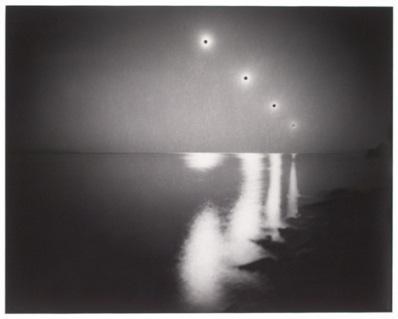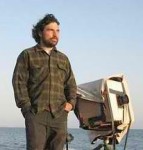
Chris McCaw
American, 1971-
Sunburned GSP #202 (SF Bay/expanding), 2008
gelatin silver print
14 ¾ x 18 ¾ in.
SBMA, Museum purchase, General Art Acquisition Fund
2008.32.1

Photo by Daniel Miller / Duncan Miller Gallery / March 31, 2008
"This project has transformed the way I think about photography and the world. Not only do I find myself using photographic materials in ways I hadn’t imagined, but I’ve also had to negotiate the physical realities of my subject as I never had to before. Having no control over the placement and movement of the sun, I have had to instead move myself and my equipment to specific locations, at specific times of the year, in order to capture the compositions I wanted.” - Chris McCaw, “Notes on Watching Shadows Move”
COMMENTS
Chris McCaw’s new (and first) monograph, Sunburn, is perhaps my favorite photobook of 2012. It is generous in size, elegantly designed, beautifully printed — and the images are truly awe-inspiring.
McCaw has always loved to play with alternate processes for making photography. When I first met him in 2004 he was making large platinum palladium prints from 35 mm photos of 1960s’ rock stars in concert; he was also building his own cameras that he could take on skateboard adventures in strange places. Over the years, he has continually pushed the boundaries of what a photograph can be.
McCaw came upon an unusual technique of making long exposures of skyscapes and landscapes quite by accident. During a camping trip, he had set up his large-format homemade camera to capture the arc of stars moving across the night sky over the course of several hours. He opened the shutter on his camera after the sun had gone down, and set his alarm to wake himself up before dawn so he could close the shutter on that single long exposure. The trouble was, he overslept, and woke up after the sun had already risen — essentially ruining that attempt to make the picture he had in mind. Nevertheless, he developed the film to see what, if anything, was there. He was amazed to find that the negative had a long thin curved hole in the middle, where the bright sun had burned an arc directly into the film with its focused heat.
Sometimes your best ideas come from being open to the possibilities that accidents expose.
Since then, he rigorously tried various methods and timings, and he got to know — intimately — the movements of the earth in relationship to the sun and moon and stars.
So what we have in Sunburn, are brilliantly calculated exposures of the sun over different horizons, forming various shapes of arcs depending on the camera’s location on the planet, and the time of year. They are made on large-format silver-gelatin printing paper (some as large as 30 x 40 inches), and each photograph includes more-or-less realistic photographic landscapes that look like solarized negatives, with skies that have been burned directly by the sun. And of course, each paper print is a one-of-a-kind photographic sculptural object.
Yet it’s not a fixed formula that he repeats. Some are single long exposures. Some are multiple shorter exposures (capturing the single sun as a series of dots burned into the sky). Others show a burning gash in the sky, only to be interrupted by a patch of cloud cover, with the burning gash returning again on the other side of the clouds. Some of the most magical and mind-boggling images are those that stretch across three separate paper negatives, sketching the arc of the sun on a single day — rising, hovering, descending — all over the same precise landscape.
- Jim Casper, LensCulture, 2013
https://www.lensculture.com/articles/chris-mccaw-sunburn
SBMA CURATORIAL LABELS
A gash. A scar. A burn. A sunburn. With extended vulnerability to the sun, Chris McCaw’s works reveal the physical presence and harmful mark of the heavens, as many images are singed during the sun’s daily journey across the sky. Here the effects of solarized paper are physically visible. This is not your typical two dimensional photograph; this was originally a photographic accident then embraced and made famous by McCaw. Using self-built large format cameras and vintage photographic paper McCaw documents astronomical occurrences with exposures ranging from fifteen minutes to twenty four hours. Rather than landscapes as photographic subject, this image from his Sunburn series glorifies the power of the sun in relation to life on earth. Though the beauty of the heavens persists, the cyclic and mighty energy of the sun is the subject McCaw investigates.
- Heavenly Bodies Exhibition, 2014
